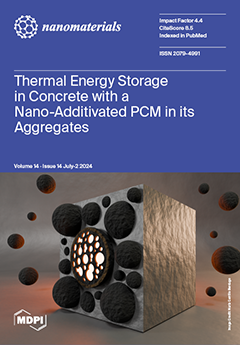Poly(3,4-ethylenedioxythiophene) (PEDOT) and PEDOT-functionalized carbon nanoparticles (f-CNPs) were synthesized by in situ chemical oxidative polymerization and pyrolysis methods. f-CNP-PEDOT nanocomposites were prepared by varying the concentration of PEDOT from 1 to 20% by weight (i.e., 1, 2.5, 5, 10, and 20 wt%). Several
[...] Read more.
Poly(3,4-ethylenedioxythiophene) (PEDOT) and PEDOT-functionalized carbon nanoparticles (f-CNPs) were synthesized by in situ chemical oxidative polymerization and pyrolysis methods. f-CNP-PEDOT nanocomposites were prepared by varying the concentration of PEDOT from 1 to 20% by weight (i.e., 1, 2.5, 5, 10, and 20 wt%). Several characterization techniques, such as field-emission scanning electron microscopy (FESEM), attenuated total reflectance-Fourier transform infrared (ATR-FTIR), X-ray diffraction (XRD), N
2 Brunauer–Emmett–Teller (BET) and Barrett–Joyner–Halenda (BJH) analyses, as well as cyclic voltammetry (CV), galvanostatic charge discharge (GCD), and electrochemical impedance spectroscopy (EIS), were applied to investigate the morphology, the crystalline structure, the N
2 adsorption/desorption capability, as well as the electrochemical properties of these new synthesized nanocomposite materials. FESEM analysis showed that these nanocomposites have defined porous structures, and BET surface area analysis showed that the standalone f-CNP exhibited the largest surface area of 801.6 m
2/g, whereas the f-CNP-PEDOT with 20 wt% exhibited the smallest surface area of 116 m
2/g. The BJH method showed that the nanocomposites were predominantly mesoporous. CV, GCD, and EIS measurements showed that f-CNP functionalized with 5 wt% PEDOT had a higher capacitive performance compared to the individual f-CNPs and PEDOT constituents, exhibiting an extraordinary specific capacitance of 258.7 F/g, at a current density of 0.25 A/g, due to the combined advantage of enhanced electrochemical activity induced by PEDOT doping, and highly developed porosity of f-CNPs. Symmetric aqueous supercapacitor devices were fabricated using the optimized f-CNP-PEDOT doped with 5 wt% of PEDOT as active material, exhibiting a high capacitance of 96.7 F/g at 1.4 V, holding practically their full charge, after 10,000 charge–discharge cycles at 2 A/g, thus providing the highest electrical electrodes performance. Hereafter, this work paves the way for the potential use of f-CNP-PEDOT nanocomposites in the development of high-energy-density supercapacitors.
Full article






